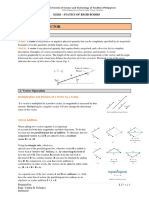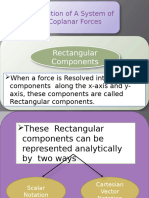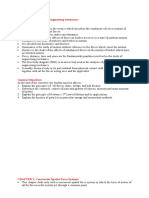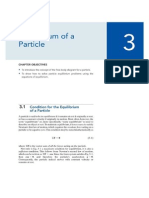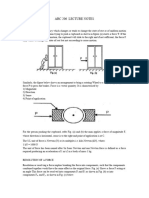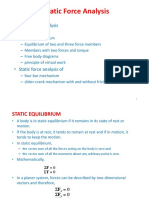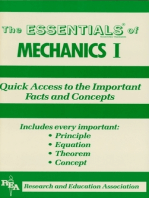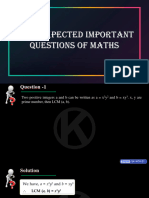0 ratings0% found this document useful (0 votes)
26 viewsVectors and Its Notations: ND RD
Vectors and Its Notations: ND RD
Uploaded by
fahimThe document summarizes key concepts about vectors and forces, including:
1) A force is a vector quantity that has magnitude, direction, and sense and adds according to the parallelogram law. Finding the resultant or resolving a force into components are important in statics.
2) The parallelogram law and trigonometric rules can be used to find the magnitude and direction of a resultant force from its components.
3) Forces can be resolved into rectangular components along x and y axes for analytical work, represented using scalar or Cartesian vector notation.
Copyright:
© All Rights Reserved
Available Formats
Download as PPTX, PDF, TXT or read online from Scribd
Vectors and Its Notations: ND RD
Vectors and Its Notations: ND RD
Uploaded by
fahim0 ratings0% found this document useful (0 votes)
26 views18 pagesThe document summarizes key concepts about vectors and forces, including:
1) A force is a vector quantity that has magnitude, direction, and sense and adds according to the parallelogram law. Finding the resultant or resolving a force into components are important in statics.
2) The parallelogram law and trigonometric rules can be used to find the magnitude and direction of a resultant force from its components.
3) Forces can be resolved into rectangular components along x and y axes for analytical work, represented using scalar or Cartesian vector notation.
Original Title
Lecture 2
Copyright
© © All Rights Reserved
Available Formats
PPTX, PDF, TXT or read online from Scribd
Share this document
Did you find this document useful?
Is this content inappropriate?
The document summarizes key concepts about vectors and forces, including:
1) A force is a vector quantity that has magnitude, direction, and sense and adds according to the parallelogram law. Finding the resultant or resolving a force into components are important in statics.
2) The parallelogram law and trigonometric rules can be used to find the magnitude and direction of a resultant force from its components.
3) Forces can be resolved into rectangular components along x and y axes for analytical work, represented using scalar or Cartesian vector notation.
Copyright:
© All Rights Reserved
Available Formats
Download as PPTX, PDF, TXT or read online from Scribd
Download as pptx, pdf, or txt
0 ratings0% found this document useful (0 votes)
26 views18 pagesVectors and Its Notations: ND RD
Vectors and Its Notations: ND RD
Uploaded by
fahimThe document summarizes key concepts about vectors and forces, including:
1) A force is a vector quantity that has magnitude, direction, and sense and adds according to the parallelogram law. Finding the resultant or resolving a force into components are important in statics.
2) The parallelogram law and trigonometric rules can be used to find the magnitude and direction of a resultant force from its components.
3) Forces can be resolved into rectangular components along x and y axes for analytical work, represented using scalar or Cartesian vector notation.
Copyright:
© All Rights Reserved
Available Formats
Download as PPTX, PDF, TXT or read online from Scribd
Download as pptx, pdf, or txt
You are on page 1of 18
2nd and 3rd Lecture
Vectors and its notations
Vector Addition of Forces
• A force is a vector quantity since it
has a specified magnitude, direction,
and sense and it adds according to
the parallelogram law.
• In statics finding the resultant force
or resolving a known force into two
components.
Finding a Resultant Force
• The two component forces F1 and F2 acting on the pin in Fig. a
• Added together to form the resultant force FR =F1 +F2.
• From this construction, or using the triangle rule, Fig. c, we can
apply the law of cosines or the law of sines to the triangle in order to
obtain the magnitude of the resultant force and its direction.
Law of sine
Law of sine
Method of finding a side
solution
Angle Finding
Angle finding method
Finding the Components of a Force
• To study pulling and pushing effect in two specific direction, it is
necessary to resolve a force into two components.
Addition of Several Forces
• If more than two forces are to be added, then parallelogram law can
be carried out in order to obtain the resultant force.
• if three forces F1 , F2 , F3 act at a point O , Fig. 2–9 , the
resultant of any two of the forces is found, say, F1 + F2 and then this
resultant is added to the third force, yielding the resultant of all three
forces; i.e.,
Addition of a System of Coplanar Forces
• When a force is resolved into two components along the x and y
axes, the components are then called rectangular components .
• For analytical work we can represent these components in one of two
ways
1. Scalar notation
2. Cartesian vector notation
Scalar Notation
• The rectangular components of force F shown in F ig. are found
using the parallelogram law, so that F = Fx + Fy . Because these
components form a right triangle, they can be determined from
Cartesian Vector Notation
• It is also possible to represent the x and y components of a force in
terms of Cartesian unit vectors i and j . They are called unit vectors
because they have a dimensionless magnitude of 1, and so they can
be used to designate the directions of the x and y axes,
respectively.
• Since the magnitude of each component of F is always a positive
quantity , which is represented by the (positive) scalars Fx and Fy ,
then we can express F as a Cartesian vector.
The Free-Body Diagram
• A drawing that shows the particle with all the forces that act on it is
called a free-body diagram (FBD).
• Two types of connections often encountered in particle equilibrium
problems:
1. Springs
2. Cables and Pulleys
Springs
Cables and Pulleys
• All cables (or cords) will be assumed to have negligible weight and
they cannot stretch
Procedure for Drawing a Free-Body Diagram
• Draw Imagine the particle to be isolated or cut “free” from its surro
Imagine the particle to be isolated or cut “free” from its
surroundings by drawing its outlined shape. undings by drawing its
outlined shape. Outlined Shape:
• Indicate on this sketch all the forces that act on the particle . These
forces can be active forces , which tend to set the particle in motion,
or they can be reactive forces which are the result of the constraints
or supports that tend to prevent motion. To account for all these
forces, it may be helpful to trace around the particle’s boundary,
carefully noting each force acting on it
You might also like
- Solution Manual For Introduction To Optimization 5th Edition by Edwin ChongDocument7 pagesSolution Manual For Introduction To Optimization 5th Edition by Edwin Chongphysics2024No ratings yet
- Lecture 3 Chapter 2 - Force Systems 2DDocument61 pagesLecture 3 Chapter 2 - Force Systems 2Drobel metikuNo ratings yet
- Chapter 4Document95 pagesChapter 4Bình NguyễnNo ratings yet
- Chapter 2 Force VectorsDocument43 pagesChapter 2 Force Vectorsaweertt80% (5)
- Review of Statics Solutions For ExamplesDocument53 pagesReview of Statics Solutions For ExamplesAnisyahira khalidNo ratings yet
- Chapter 2 Force VectorsDocument56 pagesChapter 2 Force VectorsMUHAMMAD HASSAAN KHANNo ratings yet
- JJ205 Engineering Mechanic Chapter 3 Jj205Document5 pagesJJ205 Engineering Mechanic Chapter 3 Jj205Ah TiangNo ratings yet
- Chapter 2Document59 pagesChapter 2Raghed AlsnaidNo ratings yet
- Equivalent Force Systems: This Module Aims That The Students Will Be Able ToDocument11 pagesEquivalent Force Systems: This Module Aims That The Students Will Be Able ToMONIQUE UNICO100% (1)
- Lesson 2-Topic 1 - Systems of Coplanar ForcesDocument22 pagesLesson 2-Topic 1 - Systems of Coplanar ForcesNicholas Bonn SingNo ratings yet
- Force System and EquilibriumDocument95 pagesForce System and EquilibriumLAURENT JIBUNGENo ratings yet
- Force VectorDocument12 pagesForce VectorRitwik PandeyNo ratings yet
- Topic 2. Force VectorDocument18 pagesTopic 2. Force VectorArnold Apostol Jr.No ratings yet
- Module 2 in Abe 215 Statics1 l1 5Document22 pagesModule 2 in Abe 215 Statics1 l1 5Cynel DelaNo ratings yet
- Force System and ResultantDocument20 pagesForce System and ResultantMyra GarciaNo ratings yet
- Statics of Rigid Bodies: Northern Iloilo State UniversityDocument24 pagesStatics of Rigid Bodies: Northern Iloilo State UniversityHaha AwsNo ratings yet
- Lecture 2 Chapter 2 - Part IDocument60 pagesLecture 2 Chapter 2 - Part IFeye MumichaNo ratings yet
- Emechanics M2Document13 pagesEmechanics M2ELISA LUNARNo ratings yet
- Scalars and Vectors: ScalarDocument22 pagesScalars and Vectors: Scalarsuwilanji kawambaleNo ratings yet
- Force Systems: Chapter OutlineDocument112 pagesForce Systems: Chapter OutlineAmr KhaledNo ratings yet
- L2 Equilibrium of A ParticleDocument11 pagesL2 Equilibrium of A ParticleKISAKYE MOSESNo ratings yet
- Chapter 3 Rigid BodyDocument21 pagesChapter 3 Rigid BodyimfendiNo ratings yet
- 02 Force Systems 2DDocument33 pages02 Force Systems 2DNasik AmimNo ratings yet
- Chapter - 1 - Static Force Analysis PDFDocument29 pagesChapter - 1 - Static Force Analysis PDFSourabh JangraNo ratings yet
- Equilibrium of Forces Acting at A Point: Pre-Lab QuestionsDocument6 pagesEquilibrium of Forces Acting at A Point: Pre-Lab QuestionscaliNo ratings yet
- Part1 EmotionDocument46 pagesPart1 EmotionhohoNo ratings yet
- FME Unit1.1 24-25Document12 pagesFME Unit1.1 24-25Aman SharmaNo ratings yet
- CHP 2 - Force SystemDocument15 pagesCHP 2 - Force SystemSagheer AhmedNo ratings yet
- Lecture#04Document19 pagesLecture#04Dhanesh KumarNo ratings yet
- Addition of Forces in A PlaneDocument25 pagesAddition of Forces in A PlaneLancel AlcantaraNo ratings yet
- Lecture Notes in Strength of Materials - 1Document93 pagesLecture Notes in Strength of Materials - 1Rhea MambaNo ratings yet
- Lecture 5Document17 pagesLecture 5Mr. Danish SaeedNo ratings yet
- KR10203 Chapter 1Document64 pagesKR10203 Chapter 1RINA RINANo ratings yet
- Course Outline: - Week 1, January 4 and 6Document23 pagesCourse Outline: - Week 1, January 4 and 6Michael DemianNo ratings yet
- Enggmechlesson1 2Document18 pagesEnggmechlesson1 2Raymund CarranzaNo ratings yet
- 2nd LecDocument5 pages2nd LecSalman KhanNo ratings yet
- Unit 2 Force SystemsDocument46 pagesUnit 2 Force Systemsputex247No ratings yet
- Composition of Concurrent Forces (1) Force TableDocument6 pagesComposition of Concurrent Forces (1) Force TableUgur ASİT100% (2)
- 02 Me1 PDFDocument5 pages02 Me1 PDFvat007No ratings yet
- Statics: ES 113 Mr. MoadiDocument49 pagesStatics: ES 113 Mr. MoadiDerrick Maatla MoadiNo ratings yet
- Module 1 Lesson 1Document12 pagesModule 1 Lesson 1panilagmark27No ratings yet
- Introduction To VectorsDocument16 pagesIntroduction To VectorsKeith Aubrey BidalNo ratings yet
- Equilibrium of Particles (Updated)Document37 pagesEquilibrium of Particles (Updated)kbkeng.lkNo ratings yet
- Statics: Forces Acting at A PointDocument16 pagesStatics: Forces Acting at A Pointapi-27085921No ratings yet
- ME1 Concurrent Forces and Static Equilibrium: ObjectivesDocument5 pagesME1 Concurrent Forces and Static Equilibrium: ObjectivesAhmed AbuNasserNo ratings yet
- Mec412 Chap 2 Particle PDFDocument21 pagesMec412 Chap 2 Particle PDFhidayatullahNo ratings yet
- Fundamental Principles of Mechanics: ME231: Solid Mechanics-IDocument14 pagesFundamental Principles of Mechanics: ME231: Solid Mechanics-IRohan sharmaNo ratings yet
- LN003 MN116 Force Systems PART IDocument65 pagesLN003 MN116 Force Systems PART ILAURENT JIBUNGENo ratings yet
- Engineering Mechanics: Statics: Course OverviewDocument51 pagesEngineering Mechanics: Statics: Course OverviewNazmus Sakib AlinNo ratings yet
- Statics Chapter 3Document18 pagesStatics Chapter 3Paulo MontesNo ratings yet
- Force Vectors 1Document77 pagesForce Vectors 1kabwebwalya64No ratings yet
- Structural Analysis For Architect NotesDocument82 pagesStructural Analysis For Architect NotesALAWI SSEKUBUNGANo ratings yet
- Arc 206 - Notes - 2024 - 075255Document32 pagesArc 206 - Notes - 2024 - 075255xhk25bzxzkNo ratings yet
- Engg. MechanicsDocument29 pagesEngg. MechanicsSunand Pongurlekar100% (1)
- 152lecture 1 1 Static Force Analysis of Planar Mechanism PDFDocument29 pages152lecture 1 1 Static Force Analysis of Planar Mechanism PDFSai SushmaNo ratings yet
- Work BookDocument50 pagesWork BookSimon Rupert FaderaNo ratings yet
- IE C1 Statics of Rigid Bodies Part 2 Force VectorsDocument13 pagesIE C1 Statics of Rigid Bodies Part 2 Force VectorsBernadeth MontardeNo ratings yet
- Elliptical Curve CryptographyDocument24 pagesElliptical Curve Cryptographymanish100% (1)
- Discrete Structures 4Document11 pagesDiscrete Structures 4Abdul BasitNo ratings yet
- Cat Final Book Module 1Document153 pagesCat Final Book Module 1yashvichetanranaNo ratings yet
- Homework 10 SolutionDocument2 pagesHomework 10 SolutionFilip MajstorovićNo ratings yet
- Most Expected Important Questions of MathsDocument275 pagesMost Expected Important Questions of Mathsjaigopika chakravarthiNo ratings yet
- Coding Theory and Algebraic Geometry - H. StichtenothDocument108 pagesCoding Theory and Algebraic Geometry - H. StichtenothNhan HuynhNo ratings yet
- Q. HO-KIM - Group Theory: A Problem BookDocument104 pagesQ. HO-KIM - Group Theory: A Problem Bookqhokim100% (3)
- Cryptography and Network Security: Seventh Edition by William StallingsDocument34 pagesCryptography and Network Security: Seventh Edition by William StallingsvanithaNo ratings yet
- Relation and FunctionDocument27 pagesRelation and FunctionNette Toledo100% (1)
- Unit 2: Matrices, Determinants & Systems of Linear Equations 2.1 Definitions and Basic Matrix Operations A. Definition of A Matrix and ExamplesDocument37 pagesUnit 2: Matrices, Determinants & Systems of Linear Equations 2.1 Definitions and Basic Matrix Operations A. Definition of A Matrix and ExamplesTadesseNo ratings yet
- 100 Polynomials Problems With SolutionsDocument13 pages100 Polynomials Problems With SolutionsTrong Phong NgoNo ratings yet
- Subsets of The Complex Plane: Modelled SolutionsDocument10 pagesSubsets of The Complex Plane: Modelled SolutionsMonserratt TéllezNo ratings yet
- Nikulin GrisenkiDocument45 pagesNikulin Grisenkiwapaezg045No ratings yet
- Preliminaries: Properties of IntegersDocument5 pagesPreliminaries: Properties of Integerssepti roichatul wardahNo ratings yet
- Grade 10 - Math - Real Numbers Worksheet 1Document5 pagesGrade 10 - Math - Real Numbers Worksheet 1abhinav3rdstdNo ratings yet
- Number SystemDocument44 pagesNumber Systemsarjeetsingh6350No ratings yet
- Journal of MathematicsDocument12 pagesJournal of Mathematicsrikaseo rikaNo ratings yet
- Number Theory and Modular Arithmetic ArithmeticDocument19 pagesNumber Theory and Modular Arithmetic ArithmeticSreejith ASNo ratings yet
- Notes 1.1 - Points, Lines, PlanesDocument6 pagesNotes 1.1 - Points, Lines, PlanesSusie GreenNo ratings yet
- Determinant Thay Minh ToanDocument28 pagesDeterminant Thay Minh ToanK60 Nguyễn Minh NgọcNo ratings yet
- Properties of EqualitiesDocument13 pagesProperties of EqualitiesMyla VelascoNo ratings yet
- Polynomial Characteristics HandoutDocument4 pagesPolynomial Characteristics HandoutAryan SinghNo ratings yet
- Quadratics PDFDocument9 pagesQuadratics PDFRafena MustaphaNo ratings yet
- F SquaresDocument20 pagesF SquaresIgor PavlovNo ratings yet
- HomeWork 132968473971632740Document4 pagesHomeWork 132968473971632740Urvashi RaoNo ratings yet
- Computer Methods in Power System Analysis by G.W. Stagg & A.H. El-AbiadDocument438 pagesComputer Methods in Power System Analysis by G.W. Stagg & A.H. El-Abiadkalonchito88% (17)
- Projections Onto SubspacesDocument4 pagesProjections Onto SubspacesMouhamadou Lamine DiakhameNo ratings yet
- Assignment 8 PDFDocument2 pagesAssignment 8 PDFAnil BansalNo ratings yet
- Fourier-Mukai and Nahm Transforms in Geometry and Mathematical Physics (Claudio Bartocci, Ugo Bruzzo Etc.)Document434 pagesFourier-Mukai and Nahm Transforms in Geometry and Mathematical Physics (Claudio Bartocci, Ugo Bruzzo Etc.)Diego Cancio-Donlebún FernándezNo ratings yet












